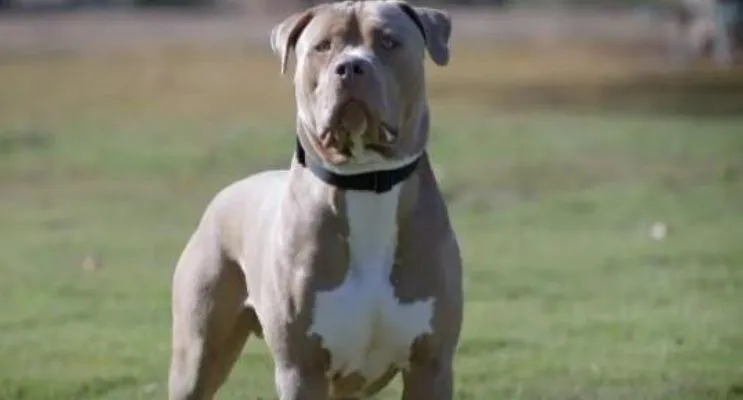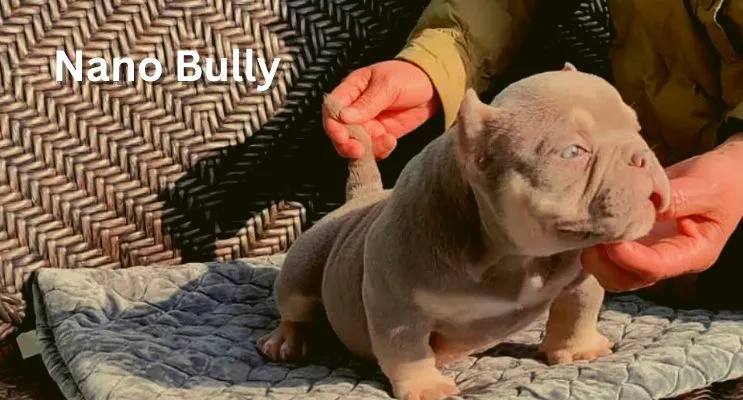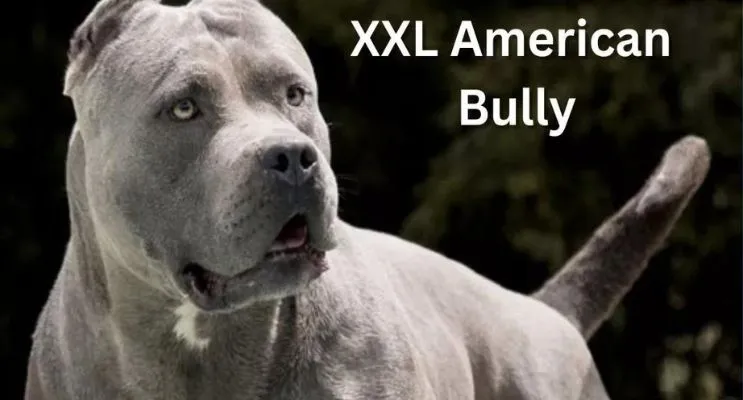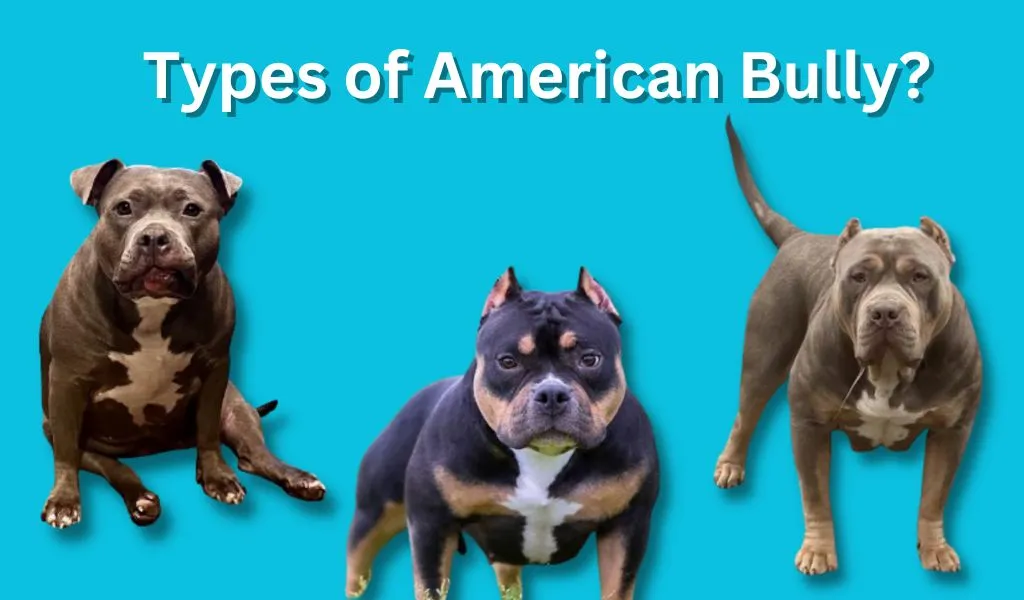The American Bully is a relatively new breed gaining popularity in the doggy world. It is the result of breeding the American Pitbull Terrier and the American Staffordshire Terrier, along with other bully dog breeds.
Despite their muscular appearance and intimidating looks, they are among the friendliest dogs out there. They were first recognized by the American Bully Kennel Club (ABKC) in 2004 and by the United Kennel Club (UKC) in 2013.
Initially, there were four types of American Bullies: Standard, Pocket, Classic, and XL Bully. However, a recent addition has been made to the American Bully category known as the “Extreme American Bully.” Currently, there are five officially recognized types of American Bully.
Additionally, there are many other types that are not officially recognized, which we will also discuss in this article in detail.
So, let’s keep moving!
Contents
5 American Bully Classes
Standard Bully

| Gender | Life Span | Height |
|---|---|---|
| Male | 8-13 years | 17-20 inches |
| Female | 8-13 years | 16-19 inches |
The Standard Bully is a popular type of American Bully known for its strong and friendly nature. It has a muscular and agile build with a broad chest and a sturdy back, giving it an impressive look.
The head has a blocky shape, a short muzzle, and wide-set eyes that show confidence and alertness.
If you’re a fan, you’ll recognize that male Standard Bullies stand between 17 to 20 inches at the withers, while females range from 16 to 19 inches.
It’s not just about looks – their temperament is stable and engaging. Standard Bullies are loyal and adaptable, making them a great choice for both new and experienced dog owners.
Main ABKC breed standards for Standard bully
- The body should be muscular with a broad chest, but nothing should be exaggerated; everything should be well-proportioned to the body.
- A big, blocky-shaped head is acceptable, but it must be proportionate to the body; a head that is too big is considered a fault.
- The muzzle should be short to medium-sized but not too short to cause difficulty in breathing. The topline of the muzzle should be in alignment with the nose.
- Oval-shaped and almond-shaped eyes are allowed; however, round eyes are considered undesirable, while bulging eyes are considered faulty.
- All eye colors are permitted except for albinism (pinkish to red), and both eyes should be of the same color. If one eye has a different color than the other, it is considered a fault.
- Thick muscular slightly arched neck and strong shoulders. skin should be tight but slightly skin is accepted.
Classic Bully

| Gender | Life Span | Height |
|---|---|---|
| Male | 8-13 years | 17-20 inches |
| Female | 8-13 years | 16-19 inches |
The Classic Bully stands out with a more refined look compared to the Standard Bully. It has a sleeker body with less bulk, yet it maintains the strength and friendly nature typical of the breed.
You can easily identify the Classic Bully by its toned muscles, which are noticeable but not as prominent as in other Bully types. It has a well-balanced frame with lighter bones than the Standard version.
Classic bully is muscular and lean giving a somewhat similar appearance to the American pitbull terrier.
When it comes to movement, the Classic Bully is agile and confident, showing off its athletic potential. Despite being less massive, it still looks powerful with a broad chest and a strong posture.
In terms of temperament, the Classic Bully is stable and engaging, making it suitable for both companionship and working roles. It’s a versatile breed, combining physical agility with a resilient disposition.
The breed standards for the Classic Bully are the same as the standard American Bully, except for the body type.
- The Classic Bully has a leaner and lighter body compared to the standard American Bully.
- It has a big head well-proportioned to the body with well-defined jaws.
- Oval or almond-shaped eyes are allowed. Any eye color is accepted, except for albinism, and blue eyes.
- The nose should not interfere with breathing, and the topline should be in line with the nose.
- Thick slightly arched neck, strong shoulders, skin can be slightly loose but it is preferred to have tight skin.
Pocket Bully

| Gender | Life Span | Height |
|---|---|---|
| Male | 12-15 years | 14-17 inches |
| Female | 12-15 years | 13-16 inches |
The Pocket Bully is the smallest type of the American Bully.
It has a smaller but strong body, showing all the typical features of the breed in a compact size.
Pocket Bullies have muscles, a broad chest, and a powerful, square head, just like the standard American Bully.
They keep the friendly and confident nature of the breed, making them good companions in various living situations. When you watch a Pocket Bully, you’ll see it walks with energy and stands strong.
Even though they are small, they still have the toughness and strength of the American Bully, making them a great example in a smaller size.
Aside from the size, it follows the same breed standards as the standard bully.
- Compact muscular body where everything is proportionate; nothing is exaggerated.
- Huge blocky head, again proportionate to the body.
- Oval or almond eyes of any color are accepted, except albino and blue. Round eyes are accepted but considered undesirable, while bulging eyes are considered a flaw.
- The muzzle should not cause difficulty in breathing, and the topline of the muzzle should be in alignment with the nose.
- Smaller compared to other bully types.
XL Bully

| Gender | Life Span | Height |
|---|---|---|
| Male | 10-12 years | 20-23 inches |
| Female | 10-12 years | 19-22 inches |
The XL Bully is bigger, showing off a strong and impressive frame that captures the breed’s power and presence.
You’ll see that the XL Bully has a sturdy skeleton, a broad chest, and well-defined muscles, sticking to the breed standards while being even larger in size.
Despite being heavier than the Standard Bully, their weight is spread evenly, preventing excessive bulkiness that could affect their health or movement.
The XL Bully’s personality remains true to the breed: confident, friendly, and easygoing.
As an owner, it’s important to give them enough space and exercise to fit their larger size, ensuring they stay in top physical and mental shape.
- The XL Bully is the biggest type of the American Bully.
- They are huge, but everything should be proportionate, and nothing should be exaggerated.
- They have a large, deep chest, strong shoulders, and a thick, muscular neck. The skin around the neck can be slightly loose, although tight skin is preferred.
- Oval or almond-shaped eyes are acceptable. Except for albinism and poorly pigmented color, every color is accepted. Round eyes are acceptable, but bulging eyes are not allowed.
Extreme Bully

Extreme Bullies are just like a standard bully, but with a more muscular and heavy body structure that really catches the eye.
You’ll see that the Extreme Bully has a sturdier bone structure compared to other types, with a broader chest, heavier bones, and a more defined blocky head.
These dogs are carefully bred to enhance these characteristics, creating a dog that looks strong and physically impressive.
Their strong muscles aren’t just for looks; they come from a focus on genetic strength. The way the Extreme Bully walks shows its powerful and confident nature, reflecting its solid build.
Even though they look imposing, it’s important to know that their appearance doesn’t solely determine their temperament.
Responsible breeding also emphasizes a balanced personality alongside physical traits.
Extreme bullies are very similar to standard bullies but some of the below points differentiate them which make you identify if your bully is an extreme bully which are as follows.
- They are slightly more muscular compared to standard bullies.
- They have variations in their lip structure they have semi-closed lips
- Their lower legs’ hocks portion is also slightly turned out.
- They have either tight or loose skin around their neck.
- It has a higher rear than standard and other bully types.
Note- The life span of the American bully can significantly vary depending on the health and how properly you take care of it.
Unofficial American Bully Types (not officially recognized)
You might hear about Micro Bully, Exotic Bully, Nano Bully, and XXL Bully – these are versions of the American Bully that big kennel clubs don’t officially recognize.
People create these unofficial types by selectively breeding dogs to emphasize certain traits like size or unique features, going beyond the standard categories.
When you look into these variations, it’s important to think about how these changes might affect the dogs’ health and behavior.
Micro Bully

Even though it’s not officially recognized, the Micro Bully is the smallest type among American Bully dogs. It’s known for being compact and muscular. The Micro Bully is usually under 13 inches tall.
Despite its small size, it still has classic Bully traits like a broad chest, strong bones, and a relatively large head. People like the Micro Bully because it’s small and easier to handle, while still having the distinctive look and temperament of the Bully breed.
But, it’s important to know that breeding for such tiny sizes can have health risks.
Nano Bully

Exploring the world of unofficial American Bully types, the Nano Bully stands out as an even smaller version. It’s known for its exceptionally small size and unique proportions that aren’t officially recognized by dog organizations.
The Nano Bully has a muscular build, a broad chest, and a relatively large head compared to its small body.
When breeding Nano Bullies, there’s often a focus on making them smaller rather than ensuring good health, leading to potential genetic issues.
If you’re a careful enthusiast, it’s important to examine the family history and health clearances to minimize possible inherited problems.
Remember, these unofficial types, including the Nano Bully, aren’t just scaled-down versions—they might also have different temperaments and care needs.
XXL bully

On the larger side compared to the Nano Bully, the XXL Bully is a remarkably big, unofficial version of the American Bully. It has a strong and muscular body that goes beyond the usual size limits for the breed.
Despite its imposing size, the XXL Bully is known for having the friendly and easygoing nature typical of American Bullies, making it a gentle giant among dogs.
This type has significant muscle mass, a wide chest, and a sturdy bone structure.
It’s important to keep an eye on the XXL Bully’s growth to prevent potential health issues like joint problems or strain on the heart.
Taking care of these extraordinary dogs requires responsible breeding and attentive care to ensure their health and well-being.
Final Thoughts
In summary, you’ve learned about different types of American Bully dogs. There’s the Standard, XL, Classic, Extreme, and Pocket Bully, each with its own unique features.
These categories officially represent the breed’s versatility, but there are also unofficial types.
As a fan of the breed, it’s important to understand the specific traits and standards for each type. This helps in responsible breeding and preserving their special qualities.

